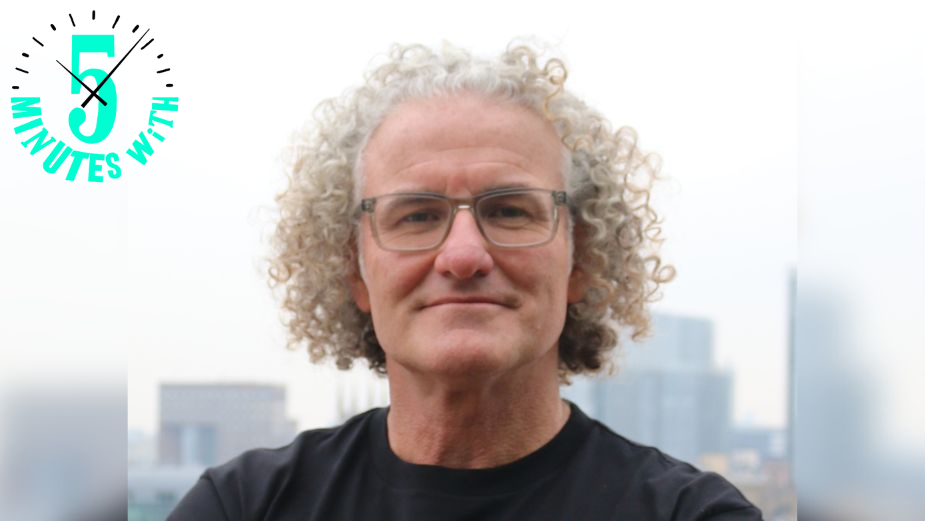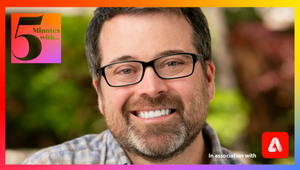
5 Minutes with… Wayne Deakin

Adobe XD is a proud supporter of LBB. Over the upcoming months, as part of the sponsorship of the ‘5 Minutes with…’ channel, we will be spending time with some of the most innovative and creative minds in the industry.
With over 25 years of industry experience working across the globe for some of the world’s best agencies and brands, Wayne Deakin has a unique perspective on what it means to create work that really resonates with people. Working at the crossroads of tech, design, and creativity, Wayne sees ‘human behaviour’ as the essential line connecting those elements, informed by his educational background in Cognitive Sciences.
Now taking up the role of global principle creative at Wolff Olins, Wayne is in charge of helping brands and businesses transform, with the help of a global team of creatives. Approaching his role through a lens that aims to give brands 'possibilities and opportunities’ - not a rigid set of rules - Wayne’s focus is all about future-proofing that centres the consumer meaningfully first and foremost.
Today, LBB spoke to Wayne about what surprised him about his role at Wolff Olins, the need to eradicate brands’ obsession with speed when it comes to UX, and why Gen Z and Alpha will be judging brands on their actions.
LBB> You have a Master’s in Cognitive Sciences. How does this inform and influence the work you do today?
Wayne> Growing up in Australia I spent far too much time surfing and having a good time, which meant education wasn’t of interest and wasn’t for me.
Then I stumbled into this industry by mistake and, after a while working for agencies, it hit me that it wasn’t all about cool design and that the key to creating great work is really understanding people and how they interact with the world. So, I juggled doing my job while learning about how we think.
Understanding how we think feels vital to me. It’s important as no matter how the technology changes or the landscape is disrupted, human behaviour is a red thread that you can connect with. Unlocking that to create emotion or change behaviours is a really cool thing.
LBB> Tell us about how your role at Wolff Olins has been going since you started - have you encountered anything you didn’t expect?
Wayne> Wolff Olins is nearly 60 years young and, as a business that’s very forward facing, it has a curious and rebellious spirit. What this means in practice is that innovation and experimentation is baked into the Wolff Olins DNA - and it’s also a big part of what I do in my role.
My role is a global one, helping push creativity and working with lots of smart people across the world to help influence the work and the team. At my core I am just a ‘creative’, and I love smart thinking and beautiful design. But I also come from a very digital and product design background, which is beneficial as it helps us ensure we create or evolve brands that are future-ready for the modern world.
No modern brand wants just a set of rules – what’s more important is giving them possibilities and opportunities.
One thing I didn’t expect when I joined is the level of innovation. I’ve looked back at older work and been constantly surprised at just how forward thinking it was for the time. It’s awesome to have that history of timeless experimentation that has both influenced culture and been ahead of trends. But equally, I know I have a lot of responsibility on my shoulders to help carry the torch forward with the team.
I work with loads of people who are way more talented than me, and, for me, that’s a good thing.
LBB> Customer experience is one of your focuses. Why is it so relevant today and why are brands struggling to get it right?
Wayne> Great brands have always been about creating experiences - be it a customer experience, an employee experience or, if a business is smart, an experience for both of these groups through the lens of holistic brand experience.
Unfortunately, the rise of digital tools has meant a lot of focus has been on technology as just a service. And this has led to an emphasis on creating seamless, consistent, or friction-free transactional or functional experiences.
Technology is awesome and it unlocks, enables, and empowers so much that is essential. But ultimately, we need to remember the importance of being human-centric when we design. That’s the real key, and it is even more important in a post-covid landscape in which customers are searching for deeper relationships.
Customers today crave digital’s power to unlock seamless interactions between physical and digital worlds, but they also need emotion and storytelling baked in. This is because great experiences are underpinned by something very ancient that’s hard-wired into our DNA from when we sat around campfires in caves: human connectivity.
Let’s remember that, while we have 300,000 years of muscle memory in our brain, digital has only been around for a few decades. So it’s important that brands and their partners work collectively on that balance.
Too often I get asked to help solve problems that are easy to solve but a client can’t see this because all they are seeing is their swimlane. And often that’s because the brand owner has forgotten the brand lens on customer experience.
How is an experience delivering the promise or values of the brand? How is the brand owner creating more than a transactional relationship? How is it building out both trust and love at the same moment?
Brands today need to be both left and right brain turbo-charged in their interactions with customers and their employees at every stage - even with the tiniest micro interaction that might not appear important – because it all adds up.
LBB> What are the biggest challenges facing brands today? Are brands focusing on the right area or is a mindset shift needed to align brands and customers more?
Wayne> Brands today need to lean in more on actions. They can’t be passengers any more as the distance between business and culture has become a lot shorter.
The largest growing audience is Gen Z and Gen Alpha and they are/will be judging your brand on actions as they choose those brands that mirror their values and beliefs. What you do is what counts today.
Social media has meant that a single tweet has the potential to wipe millions off a balance sheet, or get a CEO fired (we never had that pressure in the past). So, it is critical for a brand to build a true deep dive understanding of what it is and stands for, and to use that understanding as the foundation on which to build, shape and evolve its identity, experience and marketing in today’s new and disjointed landscape.
Recognising that every interaction, externally and internally, is a moment for brand expression and narrative is a big shift that we need to get our heads around. It’s about acknowledging each interaction as part of a narrative connecting with - and articulating - brand promise.
What a brand conveys in the language or tone of voice it uses, the talent casting in its marketing campaigns, its data or returns policies, its UX and UI – everything big or small are breadcrumbs that ladder back to what that brand stands for and what people judge against.
In the era in which we now live, trust and transparency are hyper important, and they are demonstrated and proven by actions. A CEO mindset that looks above silos and swim lanes is what’s now needed as a brand’s audiences don’t care who owns what - they just judge you from their own point-of-view.
LBB> You previously said that “our industry is still working off a lot of outdated myths, formulas, and playbooks'' - can you give some examples? Why do you think outdated thinking persists?
Wayne> To reap the full potential of a brand, brand owners and agency partners must first adjust their mindset. Yet a lot are still playing by an outdated playbook stuck in the past. They don’t know how to transform forward. And sticking to a bunch of toxic myths and false truths is making them lose customers in today’s post-covid, post-digital landscape.
The consumer landscape and play book has changed fundamentally in many ways. Here are just a few examples:
For a start, consider the tyranny of UX.
Don’t get me wrong, I love UX as I am from a product design background. But function has too often overshadowed how we experience a brand, which then cheapens a relationship to just a functional one. A foundational pillar of UX as a discipline was asking ‘how does it make you feel?’ but over a generation of designers, this was forgotten. And lots of brands now overlook that best practice thinking.
Then there’s the joy of discovery - also forgotten, and now in need of being rediscovered.
We humans crave the joy of being delighted and surprised. Yet too many brands have become obsessed with speed - the ‘cult of the three clicks’, as I call it. Frictionless speed is great in lots of contexts, but it’s less important now that technology is becoming more even. And the direct path is not always the most rewarding one.
Think of a kid in a playground faced with a choice between getting from point A to B via a slippery slide or simply walking across flat ground. I know which one will give them more joy and a sharable moment. Brands need to build discovery into their behaviours, experiences, and marketing.
Then there’s design with a capital D.
Both consumers and businesses are rediscovering the muscle of design. I am not just talking about surface level dressing elements that look cool but solid design thinking and design ethos. Consider how some of the world’s most successful brands have brought design onto the Board and baked it into the fabric of the business.
Think about Nike and its state of constant experiments and innovation. Or Apple and its design-driven obsessions. Or Spotify, Airbnb or new D2C brands like Nothing. Design now impacts not only customers but employees, markets and investors.
These are just a few examples of a dozen new guiding principles to help navigate the future.
LBB> As people’s sense of identity shifts or they adopt different identities between platforms and physical and digital worlds, can brands be expected to be everything to everyone? Should they even try?
Wayne> Brand owners need to take a more representative view of who they are serving.
Since time began, people are always searching for the ideal expression of who they are, and how they self identify. Fast-forward today and the answer isn’t just one identity or a one-note idea. Rather, people show up differently on different platforms. There’s the WhatsApp ‘you’, the Insta ‘you’, the LinkedIn ‘you’ and perhaps the metaverse ‘you’ - and each is different.
Traditional segmentation isn’t wrong. But brand owners today do need to push past demographic or psychographic generalisations to think about the personas and the context more – and, beyond that, how those personas show up differently, not just on different platforms put at different points of the day in different perspectives.
It’s about understanding the entire customer journey and finding the right moment in that journey to show up. This means not showing up everywhere along the way, but in the right places at the right time, with the right narrative or way that’s appropriate and relevant to the platform and also the version of you that is there.
At Wolff Olins, we talk about this as ‘blurred identities’ as more and more people will acknowledge their multiple identities - the different personas they have online, offline, at work, with friends, in the metaverse.
LBB> How can brands/creatives challenge their thinking? How do you challenge yours?
Wayne> See the brand as an invitation. This is the big challenge, and that means handing some control over to others.
Focus less on delivering consistency across every touchpoint and more on working with consumers or users and others as partners to create meaning and relevance. Allowing customers to try out more of a product in their own context before they buy is just one example of this. It’s less of a top-down approach, more of a side-by-side approach.
See customers – and employees – as co-creators, so part of your team. Design the version of an experience or a campaign you want and give your customers the tools and space to run with it. It should be about prioritising opportunities, not being over zealous in creating rules; possibilities not commandments.
Apple iOS16c is a good example of what I am talking about. Apple pivoted its walled garden approach by inviting people to co-create using a suite of new customisation options – such as widgets, colour options, emojis, photos or built-in wrappers – to make each user’s device unique. This approach, unthinkable a few years ago, was developed in direct response to changing customer needs.
Likewise, if you’re an ad agency working on that big campaign, how do you help give your audience tools to make it bigger? The answer is not fighting against your audience to control everything but, instead, equipping them with stuff to make them a part of the team – be that via gif, the music, or whatever.
Forget building walled gardens and letting people look in through a small control window - whatever we do, we must think about how to bring people in and be part of it. Yes, this will take confidence in your skills and trust with your clients or partners. But trust me, the output is far more interesting - and way more modern.















